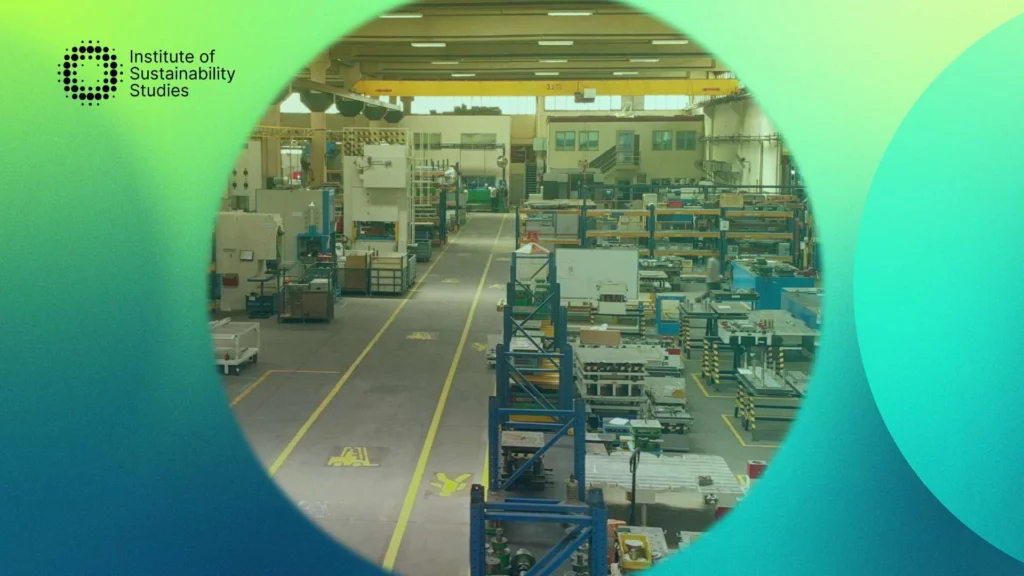Manufacturing contributes one-fifth of global carbon emissions, making it one of the most emissions-intensive sectors in the world. With rising pressure from investors, regulators, and customers, manufacturers are being pushed to decarbonise operations, cut waste, and build more resilient, transparent supply chains. In this context, corporate sustainability in manufacturing has become a top priority, but setting bold targets isn’t enough.
Achieving true sustainability in manufacturing requires deep operational change, strong cross-functional collaboration, and, crucially, the internal knowledge and skills to act. Research shows that 68 percent of sustainability initiatives stall within six months, often due to capability gaps and a lack of ownership. That’s why building ESG capability across the organisation is now a strategic imperative. Below, we break down what sustainable manufacturing means today and outline the essential steps to achieve it.
What is sustainability in manufacturing?
Sustainability in manufacturing refers to the practice of producing goods in ways that minimise negative environmental impact, conserve energy and natural resources, and enhance social and economic value over the long term. It’s about balancing profitability with responsibility, reducing harm while creating value for businesses, people, and the planet.
Below are some of its key principles:
- Resource efficiency: Green manufacturing prioritises doing more with less – reducing the use of energy, water, and raw materials. This includes upgrading equipment, optimising processes, and designing products with fewer inputs.
- Pollution and waste reduction: By limiting emissions, hazardous materials, and production waste, manufacturers can lower their environmental footprint. This includes adopting cleaner technologies and integrating waste recovery or recycling systems into operations.
- Sustainable supply chains: A responsible manufacturer looks beyond its own operations to ensure ethical sourcing, low-impact materials, and ESG-aligned supplier practices. Transparency and traceability are key.
- Innovation and circularity: Forward-thinking manufacturers are designing products and systems that fit within a circular economy, focusing on reuse, refurbishment, and closed-loop processes that reduce dependency on virgin resources.
- Workforce and community impact: Sustainability isn’t only environmental; fair labour practices, safe working environments, and meaningful engagement with local communities are essential for building long-term, inclusive value.
Unlock measurable ROI with sustainability traning that cuts costs and builds competitive edge
5 essential first steps to manufacturing net zero
Manufacturing net-zero requires a strategic, multi-phase approach that integrates emissions reduction, operational transformation, and long-term innovation. Here are the five essential steps manufacturers should take:
1. Measure emissions across scopes
Begin with a full carbon footprint assessment covering:
- Scope 1: Direct emissions from owned/controlled sources (e.g. fuel combustion)
- Scope 2: Indirect emissions from purchased electricity or heat
- Scope 3: Indirect emissions across the value chain (e.g. raw materials, logistics, end-of-life)
Establishing a baseline is critical to setting realistic targets and tracking progress.
2. Set science-based net-zero targets
Use frameworks like the Science-Based Targets initiative (SBTi) to set emissions reduction goals aligned with limiting global warming to 1.5°C. These targets should include:
- Short- and long-term decarbonisation goals
- Specific reduction commitments across scopes
- Integration with financial planning and capex strategies
3. Improve operational efficiency
Identify and implement energy and resource efficiency measures that deliver rapid emissions reductions and cost savings:
- Upgrade to high-efficiency equipment
- Reduce waste, water, and materials use
- Optimise heating, ventilation, and production scheduling
These are often the quickest wins on the path to net zero.
4. Switch to low-carbon energy
Transition energy sources to renewables wherever possible:
- Invest in onsite solar or wind generation
- Procure green electricity or long-term Power Purchase Agreements (PPAs)
- Explore alternatives to fossil fuels in industrial heat and transport
This significantly reduces Scope 2 emissions and future energy risk.
5. Invest in circularity and innovation
Redesign products and processes to support circularity and longer lifecycles:
- Use recycled or lower-emission materials
- Design for reuse, repair, or disassembly
- Innovate with low-carbon technologies (e.g. green hydrogen, electrified heat)
Also consider carbon removals or offsets only for hard-to-abate residual emissions, ideally after deep cuts.
How leading manufacturers are moving
Discover how global leaders are manufacturing net zero:
1. Unilever – Driving decarbonisation through sustainable sourcing
Unilever has cut operational emissions by 70 percent since 2008 and reduced energy use per tonne of production by 30 percent.
- Uses 100 percent renewable electricity across global sites
- Invested in heat recovery systems and smart factory optimisation
- Saved over €1.2 billion through sustainable sourcing and efficiency improvements
2. Siemens – Energy-efficient smart manufacturing
Siemens is on track to achieve net zero in operations by 2030.
- Introduced digital twin and smart building technologies
- Retrofitted plants with LED lighting, energy-efficient motors, and advanced controls
- Reduced CO₂ emissions from manufacturing by 54 percent between 2014 and 2021
3. BMW Group – Decarbonising the supply chain
BMW aims to cut CO₂ emissions per vehicle by 40 percent by 2030.
- Uses green aluminium and steel from suppliers with low-carbon processes
- In-house production powered by renewable energy
- Incorporating circular materials into EV design
4. ArcelorMittal – Steelmaking with hydrogen and carbon capture
ArcelorMittal, the world’s largest steel producer, is investing €10 billion in green steel technologies.
- Piloting hydrogen-based direct reduced iron (DRI)
- Integrating carbon capture and storage (CCS) across high-emission sites
- Aims to reduce European emissions by 35 percent by 2030
5. Encirc – Sustainability education driving operational savings
After completing ISS-led sustainability training, Encirc identified quick-win energy and waste improvements.
- Cut energy usage by 1 percent, saving €1.6 million annually
- Embedded sustainability into everyday operations and procurement
- Reduced packaging waste and material use
Final thoughts
As the path to manufacturing net zero becomes the industry standard, manufacturers that invest in operational efficiency, renewable energy, and circular design will be best positioned to cut costs, secure contracts, and stay ahead of tightening regulations.
True progress toward manufacturing net zero hinges on internal capability: teams that understand sustainability and know how to act on it. Explore our company-wide sustainability education programmes to equip your teams with the knowledge to lead, the confidence to act, and the skills to transform sustainability into business value.










